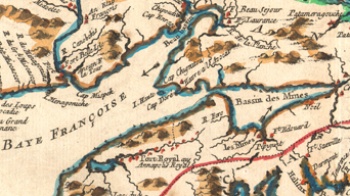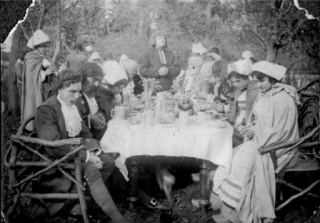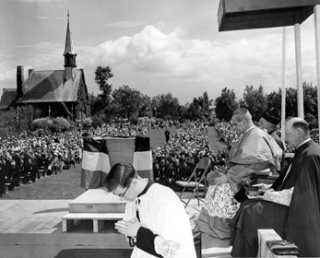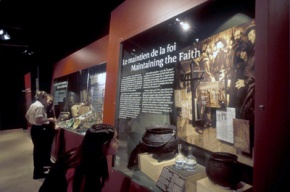Grand-Pré in Acadie
par Le Blanc, Barbara
In 1956, Grand-Pré was recognized by the government of Canada and by la Société nationale de l'Assomption, which at the time officially represented the Acadian people, as the "most important ancestral home of the Acadian people, a reminder of their most painful and most heroic hours, and it must offer future generations the example of a brave people whose culture and actions will forever enrich the Canadian nation." The site is a powerful symbol of the Acadian Deportation (1755-1762) as well as a romantic reminder of the "lost French paradise" of Acadie. Since 2012, the landscape of Grand-Pré is part of the prestigious list of UNESCO World Heritage Sites.
Article disponible en français : Grand-Pré en Acadie
Designating a Place of Collective Memory
Grand-Pré National Historic Site of Canada is located in the hamlet of the same name in Nova Scotia's Annapolis Valley, on the tourist route called the "Evangeline Trail" that runs alongside the south shore of the Bay of Fundy. This agricultural region includes farms and orchards stretching across several thousands of acres of very fertile marshland. This was where many Acadians lived before the Deportation. On the site there is a flower garden, a reception and information centre, a memorial church, the former Acadian cemetery, a blacksmith shop, and a number of commemorative monuments, the most important being the statue of the fictitious heroine Evangeline and a bust of her creator, the poet Henry Wadsworth Longfellow, as well as a sculpture representing the destiny of Acadian families during the Deportation and their hope of one day being reunited.
Since the end of the 19th century, the Grand-Pré site has been an important centre of identity and heritage for the Acadian people. It was officially designated as a historic commemoration site by the government of Canada in 1961 in order to highlight the arrival of Acadian settlers there between 1682 and 1755 and as a reminder of the Acadian Deportation that took place from 1755 to 1762. Although Grand-Pré was only one of the locations where the Acadians were rounded up before being deported, the site became an iconic site for the collective memory of this historic event. Grand-Pré has always played, and will continue to play, a key role in the construction of an Acadian identity, by fostering the creation, presentation, affirmation and validation of a feeling of belonging. The site has three main functions: it is, at one and the same time, a tourist pilgrimage site, a symbolic centre of national identity, and a symbol of the Acadians taking control of control over their own destiny.
The Founding and Destruction of an Acadian Settlement
Grand-Pré was founded in the 1680s by a couple from Port Royal, Pierre Melanson (nicknamed "la Verdure") and Marie-Marguerite Muis-d'Entremont. The site later became one of the scenes of the Acadian Deportation in 1755. As ordered by Lieutenant-Governor Charles Lawrence, the residents were deported from Bassin-des-Mines toward the Anglo-British colonies located along the Atlantic coast of the New World. This way the English hoped to solve once and for all the case of the French Catholic Acadian community inhabiting a territory that had been under English Protestant jurisdiction since the Treaty of Utrecht in 1713. Banished from the fertile and prosperous land they themselves had cleared, these deportees then experienced a period of wandering and migration as they searched for places where they could build a new life. During this time, the land that had once belonged to them in Grand-Pré was taken over by a group of New England residents, known as the New England Planters.
The American Poet Longfellow Rescues the History of the Deportation from Oblivion
Like a number of other French settlements in 18th-century Acadie, Grand-Pré too might have been forgotten had it not been for the American poet Henry Wadsworth Longfellow. After hearing the story of an Acadian girl grappling with the Deportation and its consequences, Longfellow decided to write a poem entitled Evangeline: A Tale of Acadie that was published in 1847. This poem, which quickly became an international success, touchingly describes the experience of a fictitious heroine, Evangeline, and actual events that occurred in her native village (Grand-Pré), a real-life location. The poem immediately attracted the attention of poets, academics, artists and tourists, both Acadians and non-Acadians. At the end of the 19th century, when the poem was required reading in Canadian and American schools, the popularity of the Grand-Pré site grew very rapidly indeed.
Creating a Tourist Pilgrimage Site and an Identity Symbol
From then on, the romantic image of Evangeline and of Grand-Pré, a place Longfellow describes as an earthly paradise, was used by businesses of the region (most of them Anglophone) to develop cultural tourism and commercial activities in Nova Scotia. At the same time, Evangeline and Grand-Pré served as the focal point of a rallying cry directed by the elite of the day toward the Acadian population of Canada's Atlantic provinces.
In 1907, John Frederic Herbin, a descendant of Acadians by way of his mother, Marie Robichaud, of Methegan, Nova Scotia, bought a piece of land in Grand-Pré with the intention of creating a commemorative park to honour the memory of his ancestors. In 1908, Nova Scotia enacted legislation designed to protect the site purchased by Herbin. Then, in 1917, Herbin sold the park to a railway company, Dominion Atlantic Railway (DAR), which, as a promotion tool, showcased the image of a romantic Evangeline and a pastoral Grand-Pré in order to encourage tourists, especially Americans, to visit Nova Scotia.
The 1920s and 1930s were a golden age for the Grand-Pré site and for the character of Evangeline. For instance, a Montreal newspaper, Le Devoir, sponsored two tourist trips to Acadie: the first in 1924 and the second in 1927. The paper's director, Henri Bourassa, the son of Napoléon Bourassa, who wrote the historical novel Jacques et Marie about the Acadian Deportation, took part in these two trips, which became a full-blown media event, both in Quebec and in Canada's Atlantic provinces. At this time, when Le Devoir spoke of Grand-Pré, it evoked a "land of memory," a "sacred site." Moreover, in honour of the first of these trips, the Deportation Cross was officially erected as a memorial to the Grand-Pré deportees of 1755. After having successfully operated the site for a number of years, the DAR sold the land to the federal government in 1957 and it officially became a National Historic Site in 1961.
Appropriating an Identity Symbol
No sooner
had Longfellow's story of Evangeline and the Grand-Pré site become part of the
general collective memory that many adaptations and spin-off products burst on
the scene. Inspired by the story,
a number of writers used the heroine's first name or references to the Acadians
and to places associated with her story in the titles of their works. As early as 1859, Frederic Cozzins'
book Acadie; or a Month with the Bluenoses helped perpetuate the image
of an earthly paradise and a peaceful people. A great many artists depicted Evangeline as they imagined
her to be. The Scotsman Thomas
Faed was one of the first to create a portrait of her (doing so in 1855), an
image that was appropriated by the DAR in its advertising about Nova
Scotia. An adaptation of
Evangeline's story as told in Longfellow's poem also served as the basis for
the very first Canadian feature-length film, made by the Canadian Bioscope
Company.
In 1922, it was Hollywood's turn to produce a film version of the story, starring Miriam Cooper. Another version of the story was filmed in 1929, again by Hollywood, featuring Delores del Rio in the leading role. Eventually a number of statues and statuettes, poems, comic strips, operettas, musical comedies, and even food products were inspired by the work of the American poet.
This phenomenon even reached the Cajun community of Louisiana where Evangeline served as a link between Canada's Acadian community and its cousins from the southern United States. For instance, in 1930 the American senator Dudley Le Blanc brought a delegation of Evangelines to Canada. They visited the Acadian communities of Quebec, New Brunswick and Nova Scotia, after which their Canadian counterparts returned the favour by visiting Louisiana in 1931. Since these initial contacts, Cajuns have regularly participated in commemorative events in Grand-Pré and elsewhere in Acadie.
Challenging the Identity Symbol
Although Evangeline and Grand-Pré had long served as key elements in the creation of a sense of belonging among Acadians, by the 1960s and 1970s some members of the community came to consider that these symbols represented an outdated vision of Acadie. The virtues so lyrically praised by Longfellow were not to everyone's liking. As a result, during this period of challenge to the traditional symbols of Acadie, a whole new cast of characters appeared on the scene. However, no matter how sympathetic the public found these new figures to be, Evangeline and her village continued to inhabit the Acadians' physical and mental landscape in all sorts of different ways, serving as a wellspring for their collective imagination.
Commemorating and Celebrating the Symbolic Site of Grand-Pré
In this context, throughout the 20th century and at the beginning of the 21st, commemorative events have continued to validate and legitimize Grand-Pré as an Acadian symbol in the eyes of the Acadians themselves, as well as for other Canadians and people everywhere who have been touched by Evangeline's dramatic story. In 1930, Canada's Post Office Department did its part by issuing a 50-cent stamp to commemorate the 175th anniversary of the Deportation, featuring a classic view of Grand-Pré and of Evangeline's statue.
In 1955, during the bicentennial of the Deportation, thousands of Acadians gathered in Grand-Pré to honour their ancestors. On August 15, 2004, the Acadian national holiday, a large number of Acadians again participated in a celebration at the Grand-Pré site on the occasion of the closing ceremony of the third Acadian World Congress. Most recently, in 2005, the 250th anniversary of the Deportation was commemorated by a number of activities held in Grand-Pré, and the Canada Post Corporation issued a new stamp to highlight the importance of the site and of the historical event associated with it.
Constructing an Identity for the Acadian People
All these symbolic gestures have played a significant role in the construction of an Acadian identity, serving to forge a link with a distant and tragic past so as to foster a sense of control over the present and inspire faith in a better future. By emphasizing this site, the Acadian community has been better able to answer questions concerning its identity and consolidate its sense of belonging to a Francophone culture within a majority Anglophone society. Other groups, especially the numerous visitors to Grand-Pré, have given a great deal of importance to the history and heritage represented on the site. All these social, economic and political factors combined have made Grand-Pré a place of great significance and extraordinary evocative power.
Grand-Pré National Historic Site has therefore become a tourist pilgrimage site, a symbol of Acadian identity, and a social icon not only for the Acadian community but also for visitors and for citizens of Canada and many other countries of the world. Grand-Pré and Evangeline have managed to attain a universal dimension by keeping alive the memory of a dramatic event and by commemorating the courage and perseverance of the Acadian people faced with a tragic destiny. It is in large part owing to this great evocative power that the site and its heroine remain alive in the collective memory.
An Exemplary Place of Expression for the Cultural Heritage of French North America
The Grand-Pré site and its heroine Evangeline are still being used to promote tourism and to raise awareness among Acadians concerning their history and culture. The Grand-Pré site has been in the past, and remains today, a major cultural and heritage reference point, a cathartic element, and a source of motivation not only for members of the Acadian community but also for many others as well, helping them take control over their identity and destiny in a changing world. Thus Grand-Pré plays a crucial role as a place to commemorate and celebrate the past, present and future of the Acadian people. As such, it constitutes a major heritage site for French North America.
Barbara Le Blanc
Ethnologist
Professor of Education
Université Sainte-Anne, Nova Scotia
Additional DocumentsSome documents require an additional plugin to be consulted
Images
-
 Bateaux déportation,
Bateaux déportation,
Illustration pa... -
 Expulsion of the Acad
Expulsion of the Acad
ians / La Dépor... -
 La sculpture «La Dépo
La sculpture «La Dépo
rtation», Jules... -
 Lecture de la déporta
Lecture de la déporta
tion dans la pa...
Vidéos
Documents sonores
-
 Extrait de « Evangeline Acadian Queen », interprétée par Angèle Arsenault
Extrait de « Evangeline Acadian Queen », interprétée par Angèle Arsenault
-
 Extrait de « Grand-Pré », interprétée par Angèle Arsenault
Extrait de « Grand-Pré », interprétée par Angèle Arsenault
-
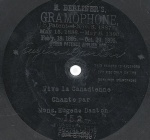 Extrait de la chanson « Evangéline », interprétée par Isabelle Roy
Extrait de la chanson « Evangéline », interprétée par Isabelle Roy
Documents PDF
-
 200e anniversaire de la Déportation acadienne de 1755 à Grand-Pré
200e anniversaire de la Déportation acadienne de 1755 à Grand-Pré
-
 Le retour à Grand-Pré
Le retour à Grand-Pré
-
 Le retour à Grand-Pré
Le retour à Grand-Pré
-
 Le retour au pays d'Évangéline
Le retour au pays d'Évangéline
Catégories
Bibliographie
Arsenault, Georges, Les Acadiens de l'Île, Les éditions d'Acadie, 1987, 296 p.
Brasseaux, Carl, Scattered to the Wind : Dispersal and Wanderings of the Acadians, 1755-1809, The Centre for Louisiana Studies, University of Southern Louisiana, 1991, 84 p.
Daigle, Jean (dir.), Acadie des Maritimes, Moncton, Université de Moncton, Chaires d'études acadiennes, 1995, 908 p.
Le Blanc, Barbara, Postcards From Acadie: Grand-Pré, Evangeline and the Acadian Identity, Kentville, Nova Scotia, Gaspereau, 2003, 204 p.
Le Blanc, Ronnie-Gilles (dir.), Du Grand-Dérangement à la Déportation : nouvelles perspectives historiques, Moncton, Université de Moncton, Chaires d'études acadiennes, 2005, 465 p. (Coll. « Mouvange ».)
Longfellow, Henry Wadsworth, Evangeline: A Tale of Acadie, New York, Houghton Mifflin, 1847, 143 p.
Ross, Sally et Alphonse Deveau, Les Acadiens de la Nouvelle-Écosse, Halifax, Nimbus, 1995, 294 p.
Viau, Robert, Les visages d'Évangeline : du poème au mythe, Québec, Éditions MNH, 1998, 190 p.
Viau, Robert, Grand-Pré : lieu de mémoire, lieu d'appartenance, Québec, Éditions MNH, 2005, 252 p.
Winslow, John. "Journal of Colonel John Winslow, of the Provincial Troops while Engaged in the Removal of the Acadian French Inhabitants of Grand-Pré, and neighbouring settlements, in the autumn of the year 1755", Collections of the Nova Scotia Historical Society, Halifax, NS, Nova Scotia Archives, 1883, p. 71-196.



